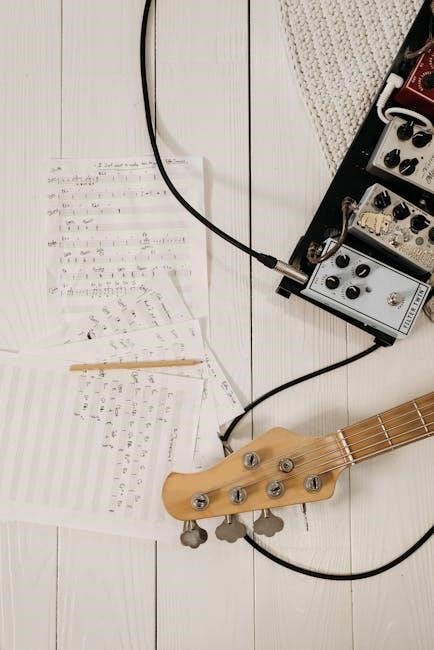Rhythm worksheets are essential tools for developing musical timing and sight-reading skills. They provide structured exercises for clapping, counting, and practicing rhythm patterns, enhancing musical understanding and precision.
Overview of Rhythm in Music Education
Rhythm is a fundamental element of music, representing the organization of sounds in time. It is essential for developing timing, coordination, and musical expression. Rhythm worksheets, particularly in PDF format, provide structured exercises for students to practice clapping, counting, and sight-reading. These tools are widely used in music education to enhance understanding of note values, time signatures, and complex patterns. By incorporating rhythm exercises into daily practice, students build a strong foundation for performing and appreciating music. These resources are invaluable for both classroom instruction and independent learning.
Importance of Practicing Rhythm
Practicing rhythm is crucial for developing musical accuracy and expression. It enhances timing, coordination, and the ability to interpret musical notation. Rhythm worksheets, especially in PDF format, offer a structured way to improve these skills. Regular practice helps musicians internalize complex patterns, ensuring smoother performances. Moreover, rhythm exercises foster discipline and consistency, which are vital for mastery. By dedicating time to rhythm practice, students and professionals alike can refine their skills and achieve a deeper understanding of musical composition and execution.

Types of Rhythm Worksheets
Rhythm worksheets vary by skill level, offering exercises for beginners, intermediate, and advanced musicians; They cover basic note values, syncopation, complex meters, and multi-time signatures, catering to diverse needs.
Beginner Rhythm Worksheets

Beginner rhythm worksheets focus on foundational concepts like whole, half, and quarter notes. They introduce basic rests, eighth notes, and simple time signatures. These exercises are designed to build a strong rhythmic foundation through clapping and counting, helping students develop timing accuracy and musical awareness. Worksheets often include visual aids and repetitive patterns, making complex rhythms accessible for new learners. They serve as a stepping stone for more advanced studies, ensuring a solid understanding of rhythm basics.

Intermediate Rhythm Worksheets
Intermediate rhythm worksheets introduce more complex patterns, such as sixteenth notes, syncopation, and compound time signatures. They build on foundational skills by incorporating rests, ties, and dotted rhythms. These exercises challenge students to clap and count accurately while exploring varied time signatures. Worksheets often include exercises that combine different note values, enhancing sight-reading abilities and rhythmic precision. They serve as a bridge between basic and advanced concepts, helping students develop a more nuanced understanding of rhythm in music.
Advanced Rhythm Worksheets
Advanced rhythm worksheets tackle intricate time signatures, polyrhythms, and complex syncopation. They often include mixed meters, rapid note transitions, and unconventional rhythmic patterns. These exercises are designed to refine a musician’s timing precision and adaptability. Students engage in challenging clapping exercises, sight-reading complex scores, and performing rhythmically demanding pieces. Advanced worksheets also incorporate rests, fermatas, and tempo changes, pushing learners to master rhythm execution at a professional level, ensuring they can handle diverse musical styles and compositions with confidence and accuracy.

Benefits of Using PDF Rhythm Worksheets
PDF rhythm worksheets offer cost-effective, printable resources for music education. They provide clear, consistent formatting and are easily accessible on various devices, making rhythmic practice flexible and efficient.
Accessibility and Convenience of PDF Format
PDF rhythm worksheets are universally accessible, compatible with all devices, and easily downloadable. They offer crisp, consistent formatting, ensuring readability and making them ideal for both in-class and remote learning environments. Students and educators can access these resources anytime, without internet dependency, fostering uninterrupted practice and learning. Additionally, PDFs are simple to print, allowing for hands-on rhythm exercises that enhance engagement and retention. Their convenience makes them a preferred choice for music education worldwide.
Customization Options for Different Skill Levels
PDF rhythm worksheets can be tailored to suit various skill levels, from beginner to advanced. Educators can select exercises focusing on specific rhythms, time signatures, or note values, ensuring targeted practice. Worksheets often include progressive difficulty, allowing students to build skills gradually. Additionally, many PDFs offer customizable templates, enabling teachers to create exercises aligned with their curriculum. This flexibility ensures that learners at all stages receive appropriate challenges, fostering steady improvement and engagement in rhythm practice.

Practice Methods for Rhythm Exercises
Effective methods include clapping and counting techniques, ensuring rhythm accuracy. Students can practice silently or aloud, using worksheets to reinforce timing and musicality through repetitive exercises.
Clapping and Counting Techniques
Clapping and counting are fundamental techniques for mastering rhythm. By clapping rhythms and counting aloud, students develop a strong internal pulse and improved timing accuracy. These exercises, often included in rhythm worksheets, help musicians internalize rhythmic patterns, making sight-reading more intuitive. Regular practice with these methods enhances coordination and musical understanding, providing a solid foundation for more complex rhythms and musical performances.
Integrating Rhythm Worksheets into Daily Practice
Incorporating rhythm worksheets into daily practice routines is essential for consistent improvement. Start with short, focused sessions, gradually increasing duration as skills develop. Use worksheets to introduce new rhythmic concepts or reinforce challenging patterns. Combine clapping and counting exercises with instrumental or vocal practice to enhance timing accuracy. For optimal results, integrate these worksheets alongside other musical activities, ensuring rhythm becomes a natural part of daily musicianship development. Regular, structured practice fosters confidence and proficiency in rhythm.

Free Rhythm Worksheet Resources
Popular websites offer free downloadable rhythm worksheets in PDF format, providing a variety of exercises for sight reading, timing, and rhythm pattern practice, suitable for all skill levels.
Popular Websites for Downloading Free Rhythm Worksheets
Several websites offer free rhythm worksheets in PDF format, catering to diverse musical education needs. MusicTheory.net provides interactive exercises and downloadable PDFs for rhythm practice. NoteFlight and Flat for Music Education also offer rhythm-specific resources. Additionally, sites like TeachMusicTheory.com and MusicEdMagic.com feature comprehensive rhythm worksheets tailored for students of all levels. These platforms ensure accessibility and variety, making rhythm practice engaging and effective for educators and learners alike.
Examples of Free Rhythm PDFs Available Online
Online platforms offer diverse free rhythm PDFs, such as “Rhythm Pizza Worksheets,” which combine music and math for engaging practice. “Sixteenth Notes Practice” and “Cut Time Exercises” PDFs are also popular, focusing on specific rhythm skills; Additionally, beginner-friendly sheets like “Eighth Note Triplets” and intermediate exercises like “Compound Meter Rhythms” are widely available. These resources are designed to cater to various skill levels, ensuring comprehensive rhythm training for students and educators.

Creating Custom Rhythm Worksheets
Custom rhythm worksheets can be created using music notation software, allowing educators to tailor exercises to specific curriculum needs and student skill levels effectively.
Tools for Designing Your Own Rhythm Exercises
Music notation software like Finale, MuseScore, and SmartMusic enables educators to create custom rhythm exercises. These tools allow for precise control over note values, rests, and time signatures. Users can design exercises tailored to specific skill levels, from basic whole notes to complex rhythms. Additionally, online platforms offer templates and interactive features, making it easier to produce engaging rhythm worksheets. Once created, exercises can be exported as PDFs for easy sharing and printing, ensuring accessibility for both in-class and at-home practice;
Aligning Worksheets with Specific Curriculum Needs
Educators can tailor rhythm worksheets to match curriculum goals by selecting exercises that address specific concepts, such as time signatures, note values, or sight-reading. PDF formats allow easy customization, ensuring exercises align with lesson plans. For example, worksheets focusing on eighth notes or triplets can support units on meter and timing. By integrating these exercises into daily practice, teachers can reinforce learning objectives and help students progress systematically. This targeted approach ensures rhythm training is both relevant and effective for diverse learning needs.

Assessment and Feedback
Rhythm worksheets enable educators to track student progress and provide constructive feedback. They help identify strengths and areas needing improvement, fostering targeted practice and skill refinement effectively.
Tracking Progress with Rhythm Worksheets
Rhythm worksheets are valuable tools for monitoring student progress in musical timing and sight-reading. By completing exercises regularly, students can improve their accuracy and rhythmical awareness. Teachers can evaluate completed worksheets to assess mastery of specific skills, such as clapping or counting complex rhythms. Over time, these assessments reveal incremental improvements, helping to identify areas where additional practice is needed. This structured approach ensures consistent growth and reinforces the fundamentals of rhythm, making it easier for students to advance in their musical education.
Providing Effective Feedback on Rhythm Exercises
Effective feedback on rhythm exercises is crucial for student improvement. Teachers should highlight specific strengths, such as accurate timing or rhythmic awareness, while gently pointing out areas needing attention. Constructive comments guide students to focus on particular skills, like maintaining steady tempo or correctly interpreting rests. Encouraging self-assessment through reflection on their performance fosters a deeper understanding of rhythm. By tailoring feedback to individual progress, educators help students refine their techniques and build confidence in their musical abilities, leading to steady advancement in rhythm mastery and overall musicianship.
Rhythm worksheets are invaluable for developing timing and musical accuracy. Regular practice enhances sight-reading and performance skills, fostering confidence and a deeper appreciation for rhythmic precision in music.
Final Thoughts on the Usefulness of Rhythm Worksheets
Rhythm worksheets are indispensable for musicians seeking to refine their timing and rhythmic accuracy. By offering structured exercises, they help build a strong foundation in music theory and performance. Whether for beginners or advanced learners, these resources provide a clear path to mastering rhythm. Their versatility allows for tailored practice, ensuring that musicians can address specific challenges and continuously improve. As a result, rhythm worksheets remain a vital tool in every musician’s educational journey.
Encouragement to Continue Practicing Rhythm
Consistent practice with rhythm worksheets yields remarkable improvements in timing and musicality. Each exercise builds confidence and skill, fostering a deeper connection with music. By dedicating time daily, musicians can overcome challenges and achieve fluency. The journey may require patience, but the rewards are profound, enhancing both performance and appreciation of music. Embrace rhythm practice as a lifelong learning process, and watch your musical abilities flourish.



